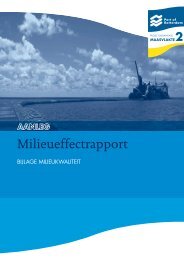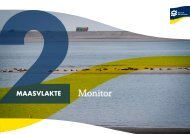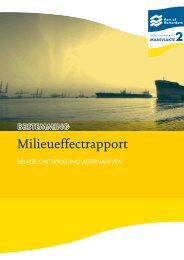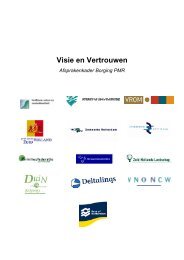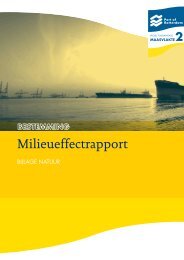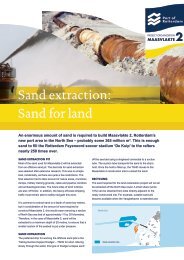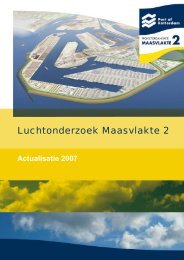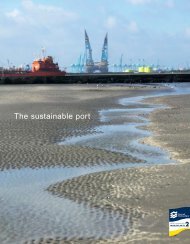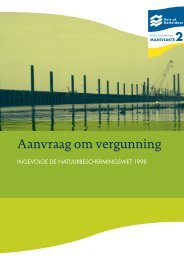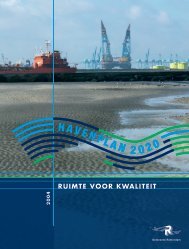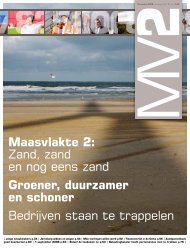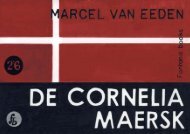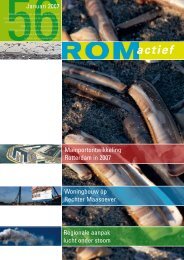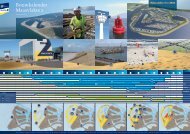brochure - Maasvlakte 2
brochure - Maasvlakte 2
brochure - Maasvlakte 2
Create successful ePaper yourself
Turn your PDF publications into a flip-book with our unique Google optimized e-Paper software.
Tomás Saraceno<br />
Solar Bell
Tomás Saraceno<br />
Solar Bell<br />
PORTSCAPES 2, MAASVLAKTE 2
Colofon<br />
Juli 2013<br />
Beeld<br />
Studio Tomás Saraceno, Bachtijar Ashari,<br />
Courtesy Parks Canada/Alexander Graham Bell National Historic Site of Canada<br />
Tekst<br />
Theo Tegelaars, Jocelyn Bethune en Havenbedrijf Rotterdam<br />
Ontwerp<br />
Edauw design<br />
SOLAR BELL<br />
Solar Bell hoort bij de aanleg van <strong>Maasvlakte</strong> 2<br />
Solar Bell van Tomás Saraceno is het laatste van een flinke reeks kunstprojecten die in de<br />
periode 2008-2013 in de Rotterdamse haven zijn gerealiseerd, tegelijkertijd met de aanleg van<br />
<strong>Maasvlakte</strong> 2. De Projectorganisatie <strong>Maasvlakte</strong> 2 van het Havenbedrijf Rotterdam wilde tijdens<br />
de uitbreiding van de haven, waarbij alles lijkt te draaien om zand, beton, steen en staal, een<br />
aantal kunstenaars hun kijk laten geven op wat hier gebeurt, de landaanwinning te observeren,<br />
analyseren en interpreteren.<br />
Want <strong>Maasvlakte</strong> 2 gaat ook over mensen, natuur en milieu, over economie en globalisering,<br />
over land versus water. Het ontstaan van het nieuwe land daagde kunstenaars uit om de<br />
totstandkoming ervan op de voet te volgen. Iedere kunstenaar deed dat op eigen wijze, vanuit<br />
een andere invalshoek en nam de ruimte om over de betekenis en toekomstige invulling<br />
van het nieuwe land te speculeren. Zo kwamen mooie, spannende en prikkelende beeld- en<br />
woordverhalen tot stand, die <strong>Maasvlakte</strong> 2 laten zien door de ogen van de kunstenaars. En zo<br />
kreeg het infrastructuurproject <strong>Maasvlakte</strong> 2 een extra, culturele dimensie.<br />
Het Havenbedrijf heeft samen met de Stichting Kunst en Openbare Ruimte (SKOR) en het<br />
Nederlands Fotomuseum (NFM) achtereenvolgens Dorothée Meyer, Marcel van Eeden, Rosa<br />
Barba, Erik Wesselo en Marie-José Jongerius gevraagd werk te maken naar aanleiding van<br />
<strong>Maasvlakte</strong> 2. Vijf jaar lang maakte het NFM van dit werk een expositie.<br />
Met SKOR zette het Havenbedrijf in 2008-2009 het project Portscapes op. Een tiental<br />
kunstenaars uit binnen- en buitenland realiseerde kunstprojecten op verschillende locaties<br />
in de bestaande haven, want <strong>Maasvlakte</strong> 2 kwam toen nog maar net boven water. Het leidde<br />
uiteindelijk tot een tentoonstelling in Museum Boijmans Van Beuningen én een vervolg onder<br />
de naam Portscapes 2.<br />
In de periode 2011-2013 kregen vier kunstenaars een grotere opdracht. HeHe maakte in mei<br />
2012 bij de opening van het recreatiestrand Roduin: een vlek rood zand die door de elementen<br />
over het strand werd verspreid, vervaagde en verdween. Jan Konings maakte bij dat zelfde<br />
strand drie grootse, permanente trappen om het duin over te steken. In 2013 maakte Fritz Haeg<br />
een blijvende alternatieve route langs de zeewering van <strong>Maasvlakte</strong> 2 waarin de dieren van<br />
het gebied worden uitgelicht. In augustus 2013 kiest Tomás Saraceno’s Solar Bell het luchtruim,<br />
als een visie op de toekomst: ruimte creëren in de lucht in plaats van het platte vlak zoals<br />
<strong>Maasvlakte</strong> 2.<br />
Als afsluiting van de kunstprojecten vindt van 29 juni tot 10 oktober een overzichtstentoonstelling<br />
van met name de vier kunstwerken van Portscapes 2 plaats in de Yangtzezaal van FutureLand,<br />
het informatiecentrum over <strong>Maasvlakte</strong> 2. Alle projecten zijn ook uitgebreid gedocumenteerd<br />
op www.portscapes2.nl.<br />
Speciale dank aan Bachtijar Ashari (TU Delft) en Jürgen Scholte-Wassink<br />
De beeldende kunstprojecten over <strong>Maasvlakte</strong> 2 zijn geïnitieerd door het Havenbedrijf<br />
Rotterdam N.V. (Projectorganisatie <strong>Maasvlakte</strong> 2) en inhoudelijk ontwikkeld en met de<br />
financiële steun van de Stichting Kunst Openbare Ruimte (SKOR) tot stand gebracht. In de<br />
zomer van 2012 heeft TAAK de rol van SKOR voortgezet. Voor het Beeldproject <strong>Maasvlakte</strong> 2<br />
werd nauw samengewerkt met het Nederlands Fotomuseum.
SOLAR BELL<br />
Solar Bell staat voor een nieuwe utopie<br />
Het kunstproject Portscapes begon met een droom. <strong>Maasvlakte</strong> 2, nieuw land uit zee. De mythe<br />
van Atlantis, de utopie van een paradijselijk gebied waar mensen in overvloed en harmonie<br />
leven en dat volgens de overlevering door verwoestende natuurkrachten verloren ging. Nu, ruim<br />
5 jaar later, staan we aan de wieg van een nieuwe utopie, het project Solar Bell van Tomás<br />
Saraceno. Een wereld niet gebouwd van zand en beton, maar van lucht en nieuwe materialen<br />
als carbon fiber. Ontworpen en gebouwd niet dankzij maar ondanks de zwaartekracht.<br />
In de periode van 2008 tot 2013 bewandelde Portscapes een spannende route langs door<br />
kunstenaars opgestelde bakens. Door een diffuse ruimte die langzaam haar contouren vond.<br />
Een ruimte waar de schijnbare, lang gevoelde tweedeling tussen natuur en cultuur geleidelijk<br />
vervaagde. In de werken van de kunstenaars kreeg de samenwerking tussen mens en natuur<br />
steeds vaker de aandacht. Steeds meer werd benadrukt dat menselijke activiteit invloed heeft<br />
op aarde en atmosfeer en dat deze invloed bewust gebruikt kan worden. <strong>Maasvlakte</strong> 2 getuigt<br />
van die invloed. De mens kan in korte tijd nieuw land creëren waar geologische processen<br />
veel langer over zouden doen. Maar tegelijkertijd is dit relatief. De mens is uiteindelijk niet<br />
opgewassen tegen natuurkrachten en de werking van de tijd. De mens vergaat, de wereld niet.<br />
De visionaire kunstenaar Tomás Saraceno deelt met zijn nieuwste project Solar Bell zijn<br />
dromen en ideeën en voegt een nieuw hoofdstuk toe aan het invloedrijke boek van Italo<br />
Calvino ‘De onzichtbare steden’ (met name het hoofdstuk ‘Vlieger-steden’). De wind, vaak<br />
een inspiratiebron voor Saraceno, is voor hem niet alleen een luchtstroming. Saraceno ziet<br />
een energetische zonnewind die op een dag sterrenschepen door de atmosfeer zal stuwen.<br />
Wind die energie opwekt en zorgt voor productie, consumptie en distributie. Saraceno: “Deze<br />
dromen herinneren ons aan de tijd waarin architectuur en kunst een vorm van communicatie<br />
waren tussen de mens en zijn natuurlijke omgeving. Er was een soort symbiose tussen die<br />
twee, samenwerking zonder overheersing.”<br />
In het interactieve, digitale tijdperk waarin we leven, delen en vergaren we vrijelijk kennis.<br />
De technische middelen hiervoor zijn steeds beter toegesneden op ons vermogen tot<br />
denken, handelen en samenwerken. Saraceno: “Wanneer de behoeften van een samenleving<br />
veranderen en evolueren in de tijd, zullen steden veranderen en ontstaan nieuwe vormen.”<br />
Saraceno vraagt zich af waarom steden niet in samenwerking en met behulp van geëngageerde<br />
burgers tot stand komen. Steden met door en voor de gebruiker gemaakte nieuwe vormen.<br />
Waar nieuw gebruik van de ruimte ontstaat en waar al het creatief, sociaal en economisch<br />
potentieel gemobiliseerd en ingezet wordt. Saraceno droomt van op de wind vliegende steden.<br />
“Als het zo winderig is als in mijn droom zou de vlieger-stad echt opstijgen. Stel je voor:<br />
gebouwen door windenergie opgetild, een hele stad vliegend in de lucht, de atmosferische<br />
omstandigheden volgend.”<br />
Het kan geen toeval zijn dat Solar Bell de naam draagt van de uitvinder Graham Bell. De man<br />
die in 1875 de telefoon bedacht, het communicatiemiddel dat de wereld veranderde. Maar Bell<br />
was ook gefascineerd door vliegende objecten. Saraceno’s vliegende sculptuur is gelamineerd<br />
met flinterdun zonnepaneel en maakt geluid. De windenergie wordt een symfonie, een ode<br />
aan de ideeën en visioenen van kunstenaars, utopisten en uitvinders.<br />
“Utopia, extropia, atopia, dystopia, en meer ... ik heb ze allemaal nodig”, zegt Saraceno.<br />
Iedere nacht droomt hij ervan. Mogelijkheden en onmogelijkheden, het perfecte scenario en<br />
het falen.<br />
Utopische dromen leiden ons naar het onmogelijke. Jules Verne zei “al dat onmogelijk is moet<br />
nog gerealiseerd worden.” Anders gezegd: als de mens zijn doelen niet hoog stelt, is er geen<br />
vooruitgang. Utopia omvat wat Saraceno betreft alles en iedereen. Samen de moed hebben<br />
om te dromen en te kiezen voor vele mogelijke toekomsten. Kunst kan hieraan een belangrijke<br />
bijdrage leveren. Als de mens iets wenst, kan het bereikt worden. Het probleem ligt in het<br />
onderkennen van de potentie van deze wensen. Veel geniale ideeën zijn al latent aanwezig en<br />
hoeven om werkelijkheid te worden alleen onderkend en geïnterpreteerd te worden.<br />
“Tussen de aarde en de ruimte, tussen kunst, architectuur, ecologie, meteorologie en<br />
astrofysica lossen traditionele grenzen op die in de weg staan van de voortuitgang”, aldus<br />
Tomás Saraceno. Spelen is een van de leerprocessen in het leven. “Het is het cultiveren van<br />
wat we niet voor mogelijk houden, te kunnen zweven.”<br />
Zoals de natuurkundige Johannes Kepler zei: “(…) the ways by which men arrive at knowledge<br />
of the celestial things are hardly less wonderfull than the nature of these things themselves.”<br />
NL
SOLAR BELL<br />
A.G. Bell experimenteerde ruim een eeuw geleden met de tetraëder<br />
Toen de uitvinder van de telefoon Alexander Graham Bell in het kleine dorpje Baddeck in de<br />
verafgelegen Canadese provincie Nova Scotia aankwam, was hij al een internationaal bekende<br />
figuur. Gedurende twee idyllische weken in september 1885 vonden Bell en zijn gezin in het<br />
plaatsje ontspanning en rust – ver van de hectiek van zijn nieuwe thuisbasis Washington D.C.<br />
en ver van de hevige strijd die over het octrooi op zijn uitvinding de telefoon werd gevoerd.<br />
Tussen de heuvels van Cape Bretoneiland, met zijn zoutwatermeren, koele klimaat en zuivere<br />
lucht, deed Bell nieuwe krachten op. Het eiland deed hem denken aan zijn geboortestreek<br />
in Schotland. Hij en zijn vrouw Mabel lieten er een landhuis bouwen, tezamen met een<br />
laboratorium dat aan veel plaatsgenoten werk bood. Het ongeveer 18 hectare grote landgoed<br />
kreeg de naam Beinn Bhreagh, dat in het Gaelic “mooie berg” betekent. Gelegen op een<br />
winderig schiereiland strekte het landgoed zich uit over heuvels en open velden – de perfecte<br />
plek om een vlieger op te laten. Maar geen gewone vliegers. Deze leken in niets op wat men<br />
in de omgeving kende – enorme cirkelvormige vliegers, vliegers met vleugels en gigantische<br />
driehoekige vliegers die groter waren dan een doorsnee huis op het 19de-eeuwse Cape Breton.<br />
Voor Bell was Baddeck een tijdelijke oase om aan het veeleisende openbare leven te<br />
ontsnappen. Maar niet aan zijn werk. Juist hier kwam zijn levenslange belangstelling voor<br />
vliegen tot bloei. Al in 1878 – nog maar anderhalf jaar na de uitvinding van de telefoon –<br />
tekende Bell het basisontwerp van een modern uitziend vliegtuig. Ook bedacht hij al dat<br />
piloten in het belang van de veiligheid een parachute moesten dragen.<br />
In Beinn Bhreagh zou hij in 1903 octrooi aanvragen op de vorm waarvoor hij uiteindelijk<br />
koos. De tetraëder had een driedimensionale structuur. Het had een sterke constructie, maar<br />
was wel van lichtgewicht materiaal. Het doel van zijn luchtvaartexperimenten was om een<br />
vlieger te bouwen die groot genoeg was om een man en een motor de lucht in te krijgen.<br />
Vliegers waren stabiel en vormden een goed uitgangspunt voor verdere experimenten<br />
met bemande vluchten. In Bells laboratorium in Beinn Bhreagh bouwden de medewerkers<br />
viervlakkige cellen ter grootte van 25 cm die werden samengevoegd tot een groter geheel.<br />
Tegelijkertijd naaiden naaisters het zijden dekkleed voor het frame.<br />
Bell was zo enthousiast over de tetraëder dat hij het ook gebruikte om driehoekige<br />
kaarsenstandaards te bouwen, een viervlakkig schuilhokje om vliegers te observeren en zelfs<br />
een 21-meter hoge uitkijktoren boven op de berg Beinn Bhreagh.<br />
Tegen 1907 richtte Bell de Aerial Experiment Association (AEA) op, met als doel “de mens<br />
de lucht in te krijgen.” Weliswaar waren de gebroeders Wright in 1903 de eerste om een<br />
bemande vlucht te realiseren, hun succes was de daaropvolgende jaren nog nagenoeg<br />
onbekend. Bells genootschap bouwde en vloog met vier vliegtuigen en twee viervlakkige<br />
vliegers, waaronder de zogenoemde “Cygnet”, een gigantische vlieger bestaande uit 3300<br />
viervlakkige cellen, maar zonder motor. Toch lukte het met deze vlieger in 1907 zeven<br />
minuten een mens te laten vliegen.<br />
Tegen het einde van zijn leven plaatse Bell zijn volledige collectie artefacten in het<br />
voormalige vliegerhuis in Beinn Bhreagh, dat informeel werd omgedoopt tot het “Museum”.<br />
Vliegers werden opgehangen aan de dakspanten. Daarnaast werden raketten die met stoom<br />
aangedreven waren en die ooit door het luchtruim hadden gesuisd in glazen vitrines<br />
uitgestald. Deze voorwerpen zouden daar tot dertig jaar na zijn dood in 1922 blijven. In de<br />
jaren vijftig doneerden de beide dochters van Bell de collectie aan de Canadese regering, op<br />
voorwaarde dat er een museum werd gebouwd in het plaatsje dat hij als zijn tweede thuis had<br />
beschouwd. In 1956 gingen de deuren van de Alexander Graham Bell National Historic Site<br />
open voor publiek in Baddeck, Nova Scotia. Het museum wordt beheerd door Parks Canada en<br />
doet verslag van het levensverhaal van Bell aan de hand van de voorwerpen die hij een eeuw<br />
geleden zorgvuldig heeft bewaard. De collectie bevat ook duizenden persoonlijke brieven en<br />
de aantekeningen van Bell, zijn vrouw en hun medewerkers bij de laboratoriumexperimenten.<br />
Veel van de brieven van Bell zijn gedigitaliseerd en kunnen online worden geraadpleegd op<br />
de website van de American Library of Congress: http://memory.loc.gov/ammem/bellhtml.<br />
Ga voor meer informatie over de Alexander Graham Bell National Historic Site in Baddeck<br />
naar: http://www.pc.gc.ca/lhn-nhs/ns/grahambell/index.aspx.
SOLAR BELL<br />
Grote vliegers zijn wetenschappelijk onontgonnen terrein<br />
Voor het ontwikkelen van zijn Solar Bell is Tomás Saraceno op zoek gegaan naar de meest<br />
geschikte materialen en alle relevante wetenschappelijke kennis. Sterker nog: bij de TU Delft<br />
is men aan de slag gegaan om een methode te ontwikkelen die voorspelt hoeveel gewicht dit<br />
soort driezijdige piramides, tetraëders, kan dragen. Daarbij blijken naast het oppervlak van de<br />
zeilen en de windsnelheid vooral de turbulenties die de tetraëder veroorzaakt belangrijk.<br />
Alexander Graham Bell, vooral bekend als uitvinder van de telefoon, deed in 1903 in Canada<br />
proeven met een vlieger in de vorm van een tetraëder. Hij noteerde hoeveel kilogram de<br />
vlieger bij welke windsnelheid kon optillen. Bell deed dat voor een reeks verschillende<br />
vliegers. Het was de tijd waarin de luchtvaart in de kinderschoenen stond. Bell staakte al snel<br />
zijn pogingen om met bestuurbare vliegers het luchtruim te kiezen. Maar zijn 100 jaar oude<br />
notities staan op internet. Het waren tot voor kort de enige serieuze onderzoeken naar het<br />
vlieggedrag van de tetrahedron.<br />
Om het vlieggedrag van Solar Bell te kunnen voorspellen en het ontwerp te optimaliseren<br />
hebben Tomás Saraceno en zijn team samengewerkt met de faculteit Luchtvaart- en<br />
Ruimtevaarttechniek van de TU Delft. Driekwart jaar heeft een student, begeleid door twee<br />
professoren, meegewerkt met het team van Saraceno om te zorgen dat Solar Bell in augustus<br />
2013 op de <strong>Maasvlakte</strong> daadwerkelijk de lucht in gaat, een zo groot mogelijk draagvermogen<br />
heeft en stabiel vliegt. Diezelfde student rondt vrijwel tegelijkertijd zijn studie af met een<br />
master thesis waarmee voorspeld kan worden welk vlieggedrag grotere exemplaren van Solar<br />
Bell zullen vertonen. Handig voor Saraceno bij de ontwikkeling van de volgende generatie<br />
van Solar Bell.<br />
Er is vrijwel geen wetenschappelijke literatuur over dit soort grote vliegers. Ook zijn er geen<br />
rekenmodellen die de turbulentie voorspellen of de krachten waaraan dit soort vliegers bloot<br />
staat. Die zijn er wel voor gebouwen, windmolens en voor vliegers die energie kunnen opwekken.<br />
De wetenschappers moesten dus leentjebuur spelen en met logisch redeneren en proeven in de<br />
windtunnel voorspellen hoe de tetraëder zich in verschillende windomstandigheden gedraagt,<br />
hoe deze het best bestuurd kan worden, waar de kabels moeten worden vastgekoppeld, waar<br />
de zeilen op het frame gespannen moeten worden etc. Daaruit werd duidelijk hoe groot<br />
de krachten in de tetraëder zijn en hoeveel gewicht de vlieger omhoog kan brengen. Die<br />
krachten zijn weer bepalend voor de sterkte die de structuur moet hebben. Door het kleinste<br />
onderdeel van de vlieger, een driezijdige piramide, te nemen en twee zijden van een vlakke<br />
plaat te voorzien maakten de wetenschappers de meest eenvoudige vorm van de tetraëder.<br />
Door in de windtunnel te variëren met de hoek waarin deze op de grond staat, bleek dat de<br />
tetraëder het snelst los van de grond komt als deze een beetje schuin voorover tegen de wind<br />
in staat. Dan is de opwaartse druk het grootst.<br />
Een tweede uitkomst van het onderzoek was dat de tetraëder een breed zog heeft. Zog is<br />
de verstoring van de wind door een object, in dit geval de vlieger. Door zog neemt de<br />
windsterkte af achter het object. Het modelleren van zog van vliegers is nieuw terrein voor<br />
de wetenschap. De TU Delft maakte een computermodel van één tetraëder. In dit model is<br />
de tetraëder met de lucht eromheen opgedeeld in een fijn grid met enkele miljoenen cellen.<br />
Daarop werd een rekenmodel losgelaten dat, door de stroming cel voor cel te berekenen,<br />
voorspelde wat er gebeurt als de luchtdeeltjes op de tetraëder botsen. De conclusie was onder<br />
andere dat de stroming zo verstoord wordt dat het niet zinvol is om binnenin de tetraëder<br />
ook zeilen op te hangen. Feitelijk sta je binnenin de tetraëder te veel in de luwte van de<br />
buitenste zeilen.<br />
Ook konden zo de eigenschappen van de vortex berekend worden: de wervel die ontstaat<br />
in de luchtstroming achter de tetraëder. Zo’n vortex wordt met een bepaalde frequentie<br />
‘afgeschud’ door de tetraëder. De frequentie wordt bepaald door de vorm van het object en<br />
de windsnelheid. Maar het object zelf heeft een resonantiefrequentie: een trillingsfrequentie<br />
waarop het object de trilling versterkt. Als de vortex- en de trillingsfrequentie hetzelfde zijn,<br />
dan versterken ze elkaar en kunnen de krachten op de structuur groter zijn dan wenselijk.<br />
De constructeur die de constructie berekent, moet weten of hij rekening moet houden met<br />
de frequentie van de vortex. De buizenconstructie wordt gemaakt van lichte, zeer sterke<br />
koolstofvezel. De zeilen van flinterdun, oprolbaar en geplastificeerd zonnepaneel.
1 Medewerkers poseren bij een grote<br />
tetraëder vlieger.<br />
Workers pose near a large tetrahedron kite.<br />
SOLAR BELL<br />
2 Alexander Graham Bell en zijn vader bekijken vliegers vanuit een schuurtje<br />
in tetraëder-vorm. Beinn Bhreagh, 1902.<br />
Alexander Graham Bell and his father sit in a tetrahedral shelter to watch<br />
kites flying at Beinn Bhreagh, 1902.<br />
3 Alexander Graham Bell en zijn kleinzoon Melville Bell Grosvenor helpen<br />
een tetraëder vlieger naar beneden te halen, Beinn Bhreagh, 1908.<br />
Alexander Graham Bell and his grandson Melville Bell Grosvenor help to<br />
pull in a tetrahedral kite at Beinn Bhreagh, 1908.<br />
4 Medewerkers proberen een neerkomende vlieger te ontwijken.<br />
Workers scramble to avoid a crashing kite, Beinn Bhreagh, 1902.<br />
2<br />
Courtesy Parks Canada/Alexander Graham Bell<br />
National Historic Site of Canada<br />
4<br />
5 Een schets van Alexander Graham Bell met een bemande tetraëder vlieger met propellers.<br />
A sketch by Alexander Graham Bell depicting a manned tetrahedral kite with propellers.<br />
1<br />
3<br />
5
SOLAR BELL<br />
6 Een computermodel van het frame van Solar Bell.<br />
A computer model for the structure of Solar Bell.<br />
7 Een computermodel van het frame van Solar Bell waarbij de vervorming<br />
door de windkrachten (overdreven) is weergegeven.<br />
A computer model for the structure of Solar Bell showing the (exaggerated)<br />
deformations of the structure under load.<br />
8 Vooraanzicht van een kleine tetraëder in de windtunnel.<br />
Front view of a tetrahedron model mounted in the wind tunnel.<br />
6 7<br />
9<br />
9 Zijaanzicht van de kleine tetraëder in de windtunnel, met links wollen draadjes<br />
om het zog te visualiseren.<br />
Side-view of the small tetrahedron in the wind tunnel with a tuft array on<br />
the left to visualize the wake behind the tetrahedron.<br />
8<br />
Bachtijar Ashari
Acknowledgements<br />
July 2013<br />
SOLAR BELL<br />
Solar Bell belongs with the construction of <strong>Maasvlakte</strong> 2<br />
Tomás Saraceno’s Solar Bell is the latest in a series of art projects completed in the port of<br />
Rotterdam between 2008 and 2013, at the same time as <strong>Maasvlakte</strong> 2 was being constructed.<br />
While the port was being expanded, a process that seemed to be all about sand, stone and steel,<br />
the Port of Rotterdam Authority’s Project Organisation <strong>Maasvlakte</strong> 2 wanted to have a number of<br />
artists give their views of the activities and observe, analyse and interpret the land reclamation.<br />
This desire evolved from the understanding that <strong>Maasvlakte</strong> 2 is also about people, nature and<br />
the environment, economy and globalisation and land versus water. The creation of new land<br />
challenged artists to closely follow the materialisation as it happened. Each artist did this in<br />
their own way, from a different perspective and took the effort to speculate on the meaning and<br />
future use of the new land. The result is beautiful, exciting, stirring visual and written stories<br />
that show <strong>Maasvlakte</strong> 2 through the eyes of the artists. The art projects gave the <strong>Maasvlakte</strong> 2<br />
infrastructure project an extra cultural dimension.<br />
The Port of Rotterdam Authority, working with the Foundation for Art and Public Domain<br />
(Stichting Kunst en Openbare Ruimte, SKOR) and the Nederlands Fotomuseum (NFM)<br />
commissioned in succession Dorothée Meyer, Marcel van Eeden, Rosa Barba, Erik Wesselo and<br />
Marie-José Jongerius, to create art works in response to <strong>Maasvlakte</strong> 2. For five years the NFM<br />
has been exhibiting this work.<br />
In 2008 and 2009, the Port Authority started the Portscapes project with SKOR. Ten artists<br />
from the Netherlands and abroad completed art projects at various locations in the existing<br />
port, because <strong>Maasvlakte</strong> 2 was just rising above the surface at the time. Ultimately, it led to<br />
an exhibition in Museum Boijmans Van Beuningen as well as a sequel, named Portscapes 2.<br />
Four artists were given an even bigger challenge in the 2011-2013 period. In May 2012, HeHe<br />
made Roduin at the opening of the recreational beach: a patch of red sand that was left to the<br />
elements and spread over the beach, eventually to fade and disappear. At that same beach, Jan<br />
Konings made three massive, permanent stairways to go over the dune. In 2013, Fritz Haeg<br />
made a lasting alternative route along the <strong>Maasvlakte</strong> 2 seawall, along which local animals are<br />
described. In August 2013 Tomás Saraceno’s Solar Bell will take to the air as a vision of the<br />
future: creating space in the air rather than on the surface, like <strong>Maasvlakte</strong> 2.<br />
To conclude the art projects, a retrospective exhibition is being held from 29 June to 10 October,<br />
reviewing the four Portscapes 2 works in particular. This will be held in the Yangtzezaal of<br />
FutureLand, the <strong>Maasvlakte</strong> 2 information centre. All of the projects are also well documented<br />
on www.portscapes2.nl.<br />
Pictures<br />
Studio Tomás Saraceno, Bachtijar Ashari,<br />
Courtesy Parks Canada/Alexander Graham Bell National Historic Site of Canada<br />
Text<br />
Theo Tegelaars, Jocelyn Bethune and the Port of Rotterdam Authority<br />
Design<br />
Edauw design<br />
Special thanks to Bachtijar Ashari (TU Delft) and Jürgen Scholte-Wassink<br />
The <strong>Maasvlakte</strong> 2 art projects were initiated by the Port of Rotterdam Authority (<strong>Maasvlakte</strong> 2<br />
Project Organisation). The content was developed in collaboration with the Foundation for<br />
Art and the Public Domain (Stichting Kunst Openbare Ruimte, SKOR), which also provided<br />
financial support. In the summer of 2012, TAAK took over SKOR’s role. The <strong>Maasvlakte</strong> 2<br />
photo project has enjoyed close cooperation with the Nederlands Fotomuseum.
SOLAR BELL<br />
Solar Bell represents a new utopia<br />
The Portscapes art project started with a dream: <strong>Maasvlakte</strong> 2, new land from the sea. The<br />
myth of Atlantis, the utopian paradise where people live in abundance and harmony and which,<br />
according to folklore, was lost to the destructive forces of nature. Now, over 5 years later, a new<br />
utopia beckons: Tomás Saraceno’s Solar Bell project. A world not made from sand and cement,<br />
but from air and new materials like carbon fibre. Designed and built not because of but in spite<br />
of gravity.<br />
From 2008-2013, Portscapes walked an exciting route along landmarks drawn by artists.<br />
Through a diffuse space that slowly found its contours. A space where the seemingly long felt<br />
dichotomy between nature and culture gradually faded. In the artists’ works, there was an<br />
increasing focus on the interaction between people and nature. The fact that human activity<br />
affects the planet and the atmosphere, and that this influence can be intentionally used,<br />
began to receive more and more emphasis.<br />
<strong>Maasvlakte</strong> 2 is a witness to this influence. Man can create new land in a short period of<br />
time, while geological processes would take much longer. But at the same time, this influence<br />
is relative. Man is ultimately no match against the forces of nature and the effects of time.<br />
Man perishes, but the world does not.<br />
With his latest project, Solar Bell, the visionary artist Tomás Saraceno shares his dreams and<br />
ideas and adds a new chapter to Italo Calvino’s influential book ‘Invisible Cities’ (especially<br />
the chapter ‘Cities & The Sky’). The wind, often a source of inspiration for Saraceno, is not<br />
just a gust of air. Saraceno sees a dynamic solar wind that will one day propel star ships<br />
through the atmosphere. Wind that creates energy and generates production, consumption<br />
and distribution. Saraceno: “These dreams remind us of the time when architecture and art<br />
were a form of communication between man and his natural environment. There was a kind<br />
of symbiosis between the two, interaction without domination.”<br />
In our interactive, digital age, we share and collect information freely. The technical means<br />
for this are increasingly tailored to our ability to think, act and cooperate. Saraceno: “When<br />
the needs of a society change and evolve over time, cities will change and new forms will<br />
develop.” Saraceno wonders why cities are not created with the cooperation and help of<br />
engaged citizens. Cities with forms made by and for the user. Where new use of space arises<br />
and where all the creative, social and economic potential is mobilised and used. Saraceno<br />
dreams of cities flying on the wind. “If it’s as windy as in my dreams, then the kite-city would<br />
actually take off. Imagine: buildings lifted up by wind energy, an entire city flying through<br />
the air, following the atmospheric conditions.”<br />
It can’t be a coincidence that Solar Bell bears the name of the inventor Alexander Graham<br />
Bell. The man who invented the telephone in 1875, the form of communication that changed<br />
the world. But Bell was also fascinated by flying objects. Saraceno’s flying sculpture is<br />
laminated with whisper-thin solar panels and it makes a noise. The wind energy becomes a<br />
symphony, an ode to the ideas and visions of artists, utopians and inventors.<br />
“Utopia, extropia, atopia, dystopia, and more … I need them all”, Saraceno says. He dreams<br />
of them every night. Possibilities and impossibilities, the perfect scenario and failure.<br />
Utopian dreams lead us to the impossible. Jules Verne said “All that is impossible remains<br />
to be achieved.” In other words, if man does not set his sights high, there is no progress.<br />
As far as Saraceno is concerned, utopia includes everything and everyone. Together, having<br />
the courage to dream and to opt for many possible futures. Art can make an important<br />
contribution here. If man wishes for something, it can be achieved. The problem lies in<br />
recognising the potential of these wishes. Many brilliant ideas are already present and only<br />
need to be recognised and interpreted to become reality.<br />
“Between earth and space, between art, architecture, ecology, meteorology and astrophysics,<br />
traditional borders that stand in the way of progress dissolve,” says Tomás Saraceno. Playing<br />
is one of the learning processes in life. “It is the cultivation of what we do not think is<br />
possible, to be able to float.”<br />
As the physicist Johannes Kepler said: “(…) the ways by which men arrive at knowledge of<br />
the celestial things are hardly less wonderful than the nature of these things themselves.”<br />
ENG
SOLAR BELL<br />
100 years ago A.G. Bell experimented with the tetraëder<br />
By the time telephone inventor Alexander Graham Bell arrived in the tiny village of Baddeck in<br />
the far-flung Canadian province of Nova Scotia, he was already an internationally known figure.<br />
For two idyllic weeks in September of 1885, Bell and his family found relaxation and peace<br />
here – far from the intense heat of his adopted home of Washington, D.C.; far from the intense<br />
patent fights over his telephone invention.<br />
The Cape Breton hills, with its saltwater lochs and cooler climate had a restorative air. It<br />
also reminded Bell of his childhood home in Scotland. Here, with his wife Mabel, he built<br />
a mansion and a laboratory that employed many locals. He called the 450-acre estate Beinn<br />
Bhreagh, Gaelic for ‘beautiful mountain’. Perched on a wind-swept peninsula, it had vast hills<br />
and open fields – the perfect place to fly a kite. But not typical kites. These kites were unlike<br />
anything seen here before – huge circular kites, kites with wings and gigantic triangular kites<br />
bigger than the typical 19th century Cape Breton house.<br />
For Bell, Baddeck was a seasonal oasis from the demands of public life. But not from work.<br />
It was here that his lifelong interest in flight blossomed. As early as 1878 – just a year and<br />
a half after inventing the telephone, Bell had sketched the basic design of a modern-looking<br />
aircraft. He also noted that in the interest of safety, pilots should wear a parachute.<br />
At Beinn Bhreagh, his choice of shape was one he would patent in 1903. The tetrahedron<br />
was a three dimensional structure. It was strong, yet lightweight. His goal with these early<br />
aviation experiments was to build a kite large enough to carry a man and a motor into the air.<br />
Kites offered stability and were a good testing ground for further manned flight experiments.<br />
At the Beinn Bhreagh laboratory, workers constructed the 10 inch tetrahedral cells that were<br />
connected into much larger forms, while seamstresses sewed silk coverings onto the frames.<br />
Bell loved the simple design and used the tetrahedron to construct triangular candlestick<br />
holders, a tetrahedral kite viewing shelter and even a 21-meter viewing tower atop Beinn<br />
Bhreagh mountain.<br />
By 1907 Bell formed the Aerial Experiment Association (AEA) with the goal to ‘get a man<br />
into the air’. While the Wright Brothers would be the first to achieve manned flight in North<br />
America in 1903, their success was virtually unknown for years afterward. Bell’s group built<br />
and flew four planes and two tetrahedral kites, including the ‘Cygnet’, a gigantic kite with<br />
3300 tetrahedral cells, but no motor. Still, it carried a man aloft for 7 minutes in the fall of<br />
1907, proving to Bell that the form was stable enough to fly with a man on board.<br />
Toward the latter part of his life, Bell maintained his collection of artifacts and housed them<br />
in the former kite house at Beinn Bhreagh, calling it informally ‘The Museum’. There, one-<br />
time kite experiments were displayed suspended from the building’s rafters; while steampowered<br />
rockets that once whizzed overhead were placed in glass cases. The items remained<br />
there for three decades after his death in 1922. In the 1950’s Bell’s daughters, donated the<br />
collection to the Canadian government, on the condition that a museum honouring their<br />
father be constructed in the village he considered a second home. In 1956, the Alexander<br />
Graham Bell National Historic Site was opened to the public in Baddeck, N.S. Operated by<br />
Parks Canada, Bell’s life story is told through the items he so carefully preserved almost a<br />
century ago. Included in the collection are thousands of personal letters, laboratory and<br />
experiment notes written by Bell, his wife and his associates.<br />
Many of Bell’s letters have been digitized and are available online at the American Library<br />
of Congress website found here: http://memory.loc.gov/ammem/bellhtml.<br />
For more information on the Alexander Graham Bell National Historic Site in Baddeck, N.S.<br />
visit http://www.pc.gc.ca/lhn-nhs/ns/grahambell/index.aspx.
SOLAR BELL<br />
Giant kites are new scientific territory<br />
Tomás Saraceno went on a hunt for the most suitable materials and any relevant scientific<br />
knowledge for his work on the development of the Solar Bell. In fact, researchers at Delft<br />
University of Technology even set to work developing a method to predict the weight that can<br />
be supported by the triangular pyramids or tetrahedrons, that make up the kite. It also turns out<br />
that in addition to the surface of the sails and the wind speed, the turbulences the tetrahedron<br />
creates are particularly important: the wake and the so-called vortices within.<br />
Alexander Graham Bell, primarily known for his invention of the telephone, ran tests in<br />
Canada in 1903 with a tetrahedral kite. He noted down the number of kilograms the kite<br />
could lift at what wind speed. Bell repeated this test for a series of different kites. Aviation<br />
was still in its intancy. Bell quickly broke off his tests to take to the air with navigable kites.<br />
His century-old notes, however, were put on the internet by the organisation that manages<br />
his estate. Until recently, these were the only serious investigations into the flight behaviour<br />
of tetrahedrons.<br />
In order to be able to predict the flight behaviour and optimise the design, Tomás Saraceno<br />
and his team worked with Delft University of Technology’s Faculty of Aerospace Engineering.<br />
For three quarters of a year one student, mentored by two professors, worked with Saraceno’s<br />
team to ensure that Solar Bell, which will be presented on the <strong>Maasvlakte</strong> in August 2013,<br />
will actually go into the air and fly stably with the greatest possible lift. That same student<br />
will complete his master’s degree at around the same time, presenting a thesis that describes<br />
how, based on theory and research, the flight behaviour of larger versions of Solar Bell can<br />
be predicted. Saraceno can also use that study in the development of the next generation of<br />
Solar Bell.<br />
There is virtually no scientific literature regarding this kind of giant kite. There are no<br />
calculation models to predict the turbulence or the forces these kites are exposed to, either.<br />
Such things do exist for buildings, windmills and kites that generate electricity, but the<br />
scientists had to borrow from other models and use logical reasoning and wind tunnel tests<br />
to predict how the tetrahedron would behave in various wind conditions, how it could best be<br />
controlled, where the cables should be attached, where the sails should be stretched over the<br />
frame, etc. All of this research revealed the strength of the forces on the tetrahedron and the<br />
weight the kite can lift into the air. These forces determine the structural strength required.<br />
By taking the smallest component of the kite, a triangular pyramid and giving two sides a flat<br />
plate, the scientists created the simplest shape of the tetrahedral kite. By varying the angle<br />
this formed with the ground, wind tunnel tests showed that the kite comes off the ground<br />
fastest when it leans slightly into the wind. At this angle the lift is at its greatest.<br />
A second result of the wind tunnel research was the discovery that the tetrahedron has a wide<br />
wake. A wake is a wind disruption caused by an object, in this case the kite. Wake causes the<br />
strength of the wind to decrease behind the object. Modelling kite wake is a new challenge<br />
for science. In order to be able to say something about the wake of the tetrahedral kite, Delft<br />
University of Technology made a computer model of a single tetrahedral unit. In this model,<br />
the tetrahedron and the air around it are divided into a fine grid with millions of cells.<br />
A calculation model was applied that, by calculating the flow cell by cell, predicted what<br />
would happen, if the air particles on the tetrahedron collided. The conclusion was that the<br />
flow would be so disrupted that it would be of no benefit to also hang sails within the<br />
tetrahedron; the wind there is far too weak. Inside the tetrahedron is too sheltered by the<br />
outer sails.<br />
These models also allowed the properties of the vortex to be calculated. The vortex is the eddy<br />
formed in the air stream behind the tetrahedron. Such a vortex is shed by the tetrahedron at<br />
a certain frequency. This frequency is determined by the shape of the object and the wind<br />
velocity. But the object itself also has a resonant frequency – a frequency of vibration at<br />
which the object amplifies the vibration. If the vortex frequency and vibration frequency are<br />
the same, they reinforce each other and the forces acting on the structure can become larger<br />
than desired. The designer calculating the construction needs to know, if the vortex frequency<br />
must be kept in mind. The tube structure is made of light, extremely strong carbon fibre. The<br />
sails are made of wafer-thin, rollable, plasticised solar panels.
Augustus 2013, Tomás Saraceno’s Solar Bell kiest het luchtruim, als een visie op de toekomst:<br />
ruimte creëren in de lucht in plaats van het platte vlak zoals <strong>Maasvlakte</strong> 2. De beelden in deze<br />
<strong>brochure</strong> zijn ontwerpen van Solar Bell. Boven <strong>Maasvlakte</strong> 2, de uitbreiding van de haven van<br />
Rotterdam, vliegt in augustus 2013 een kleinere versie.<br />
August 2013, Tomás Saraceno’s Solar Bell will take to the air as a vision of the future: creating<br />
space in the air rather than on the surface, like <strong>Maasvlakte</strong> 2. The images in this <strong>brochure</strong><br />
are designs of Solar Bell. In August 2013 above <strong>Maasvlakte</strong> 2, the expansion of the port of<br />
Rotterdam, a smaller version will fly.



